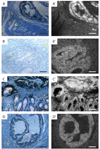Activation of Notch signaling in human colon adenocarcinoma
- PMID: 19020755
- PMCID: PMC2739737
- DOI: 10.3892/ijo_00000112
Activation of Notch signaling in human colon adenocarcinoma
Abstract
Notch and Wnt signaling function together to regulate colonic progenitor cell division and differentiation. Studies in mice have also shown that Notch signaling is required for adenoma formation in response to elevated Wnt-pathway signaling that occurs in the APCMin mouse model of human adenomatous polyposis coli. We therefore used in situ hybridization to analyze expression of Notch ligands, receptors and fringe genes, as well as the Notch target gene, HES1, in human colorectal cancer (CRC). In a small cohort of tumors, JAGGED ligands, NOTCH1, LFNG and HES1 were expressed at levels similar to, or higher than, levels observed in the crypt. To explore the possibility that Notch signaling may play a quantitative role in human CRC we next analyzed HES1 mRNA expression in 130 tumors, each associated with outcome data. The vast majority of these tumors expressed HES1, although at varying levels. Absolute expression levels did not correlate with patient survival. These results establish that JAG ligands and NOTCH1, as well as Notch receptor activation are consistent features of human CRC and support the notion that many of these tumors, like the APCMin mouse, may respond to anti-Notch therapeutic regimes.
Figures


Similar articles
-
Notch-Hes1 pathway contributes to the cochlear prosensory formation potentially through the transcriptional down-regulation of p27Kip1.J Neurosci Res. 2009 Dec;87(16):3521-34. doi: 10.1002/jnr.22169. J Neurosci Res. 2009. PMID: 19598246
-
[Expression changes of Notch-related genes during the differentiation of human mesenchymal stem cells into neurons].Sheng Li Xue Bao. 2007 Jun 25;59(3):267-72. Sheng Li Xue Bao. 2007. PMID: 17579779 Chinese.
-
Impaired expression of Notch signaling genes in aged human skeletal muscle.J Gerontol A Biol Sci Med Sci. 2007 Jan;62(1):9-17. doi: 10.1093/gerona/62.1.9. J Gerontol A Biol Sci Med Sci. 2007. PMID: 17301032
-
Role of Notch signaling pathway in gastric cancer: a meta-analysis of the literature.World J Gastroenterol. 2014 Jul 21;20(27):9191-9. doi: 10.3748/wjg.v20.i27.9191. World J Gastroenterol. 2014. PMID: 25083094 Free PMC article. Review.
-
Notch receptor-ligand binding and activation: insights from molecular studies.Semin Cell Dev Biol. 2012 Jun;23(4):421-8. doi: 10.1016/j.semcdb.2012.01.009. Epub 2012 Feb 4. Semin Cell Dev Biol. 2012. PMID: 22326375 Free PMC article. Review.
Cited by
-
Wnt, Notch, and TGF-β Pathways Impinge on Hedgehog Signaling Complexity: An Open Window on Cancer.Front Genet. 2019 Aug 21;10:711. doi: 10.3389/fgene.2019.00711. eCollection 2019. Front Genet. 2019. PMID: 31552081 Free PMC article. Review.
-
Ret kinase-mediated mechanical induction of colon stem cells by tumor growth pressure stimulates cancer progression in vivo.Commun Biol. 2022 Feb 17;5(1):137. doi: 10.1038/s42003-022-03079-4. Commun Biol. 2022. PMID: 35177769 Free PMC article.
-
Lentinan enhances the antitumor effects of Delta-like 1 via neutrophils.BMC Cancer. 2022 Aug 25;22(1):918. doi: 10.1186/s12885-022-10011-w. BMC Cancer. 2022. PMID: 36008793 Free PMC article.
-
Notch1 regulates the effects of matrix metalloproteinase-9 on colitis-associated cancer in mice.Gastroenterology. 2011 Oct;141(4):1381-92. doi: 10.1053/j.gastro.2011.06.056. Epub 2011 Jun 30. Gastroenterology. 2011. PMID: 21723221 Free PMC article.
-
NOTCH Signaling and ATOH1 in Colorectal Cancers.Curr Colorectal Cancer Rep. 2011 Jun;7(2):121-127. doi: 10.1007/s11888-011-0090-5. Curr Colorectal Cancer Rep. 2011. PMID: 21980310 Free PMC article.
References
-
- Jemal A, Thomas A, Murray T, Thun M. Cancer statistics, 2002. CA Cancer J Clin. 2002;52:23–47. - PubMed
-
- Vogelstein B, Kinzler KW. Cancer genes and the pathways they control. Nat Med. 2004;10:789–799. - PubMed
-
- Gregorieff A, Clevers H. Wnt signaling in the intestinal epithelium: from endoderm to cancer. Genes Dev. 2005;19:877–890. - PubMed
-
- Batlle E, Henderson JT, Beghtel H, van den Born MM, Sancho E, Huls G, Meeldijk J, Robertson J, van de Wetering M, Pawson T, Clevers H. Beta-catenin and TCF mediate cell positioning in the intestinal epithelium by controlling the expression of EphB/ephrinB. Cell. 2002;111:251–263. - PubMed
Publication types
MeSH terms
Substances
Grants and funding
LinkOut - more resources
Full Text Sources
Other Literature Sources

